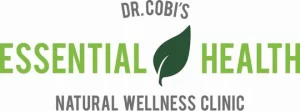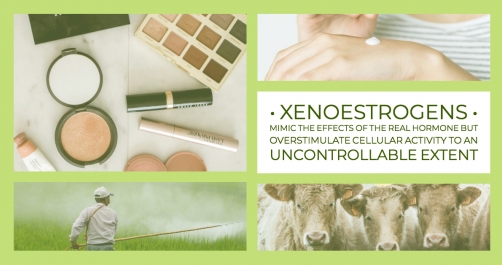When it comes to hormone health, some of the biggest problems could be in plain sight in your bathroom, bedroom and kitchen. Lots of ingredients in your beauty and bathroom products contain chemicals that are known as endocrine disruptors. These have the ability to mimics the effects of key hormones, which can have a serious effect on your health. Some of the hormones that can be affected include estrogen (a female sex hormone), androgens (a male sex hormone) and thyroid hormones. Endocrine disruptors can change the way that these types of hormones are produced or used in your body.
Here are some interesting facts to consider:
- By the time the average North American woman has completed her morning routine, she has exposed her face, body and hair to over 126 chemicals from 12 different products.
- According to the Environmental Protection Agency, 60% of what you put on your skin enters your blood stream and every organ in your body within 26 seconds!
- The average North American contains 148 synthetic/toxic chemicals stored in the body.
- Only 11% of the 10,500 chemicals in cosmetics have been tested for safety!
- Xenoestrogens are not found in nature as they are man-made toxins that are estrogen imposters.
- Xenoestrogens mimic the effects of the real hormone but overstimulate cellular activity to an uncontrollable extent.
- There are 70,000 registered chemicals known as estrogen disruptors (xenoestrogens)!
Let’s talk a look at some of the big culprits:
Personal care products: Shampoos, deodorants, moisturizers and makeup (to name but a few) can contain phthalates and triclosan. Phthalates are a “gender bending” chemical that have been linked to feminization of males in many species of wildlife.
Canned foods: Even your kitchen cupboards can be a dangerous place, with Bisphenol-A (BPA) found in many canned products. BPA is a known endocrine disruptor that can mimic estrogen and can alter immune function, increase your risk of obesity, encourage hyperactivity in children, and affect prostate health. It’s also linked to some cancers.
Try these brands: San Remo Organics, Eat Wholesome Food Co., Amy’s Organics, Pacific, Trader Joe’s and Imagine
Non-organic food: Pesticides can be hormone disrupting, as can herbicides. Eating organic foods can cut the risk factor.
- Avoid all pesticides, herbicides and fungicides
- Choose organic, locally-grown and in-season foods
- Peel and thoroughly wash non-organic fruits and vegetables
- Buy hormone-free meats and dairy products to avoid hormones and pesticides
Try these brands: Organic food delivered right to your door- www.spud.ca; www.bluemoonorganics.com; www.chefsplate.com
Plastic food containers and non-stick cookware: There’s yet another set of culprits in your kitchen in the form of plastic food containers and non-stick pans. Both of these can be sources of endocrine disruptors. Plastic containers can contain BPA, while non-stick cookware can expose you to perfluorooctanoic acid (PFOA). The latter is linked to fertility problems, reproductive problems, developmental issues and thyroid problems.
Cooking and plastics
- Do not heat food in plastic containers
- Only use glass containers when heating foods
- Avoid Styrofoam containers as they contain BPA (drinking coffee out of a Styrofoam cup causes the BPA to leach out into the coffee)
- Avoid Teflon-coated nonstick pans which, if overheated, can release endocrine-disrupting compounds
Try these brands: Click here for the top 10 nonstick pans http://www.allcookwarefind.com/Non-Stick/
Food-storage containers
- Store your food in glass, ceramic or stainless-steel food storage containers
- Some plastic cling wrap is made from PVC (polyvinyl chloride) which contains several types of xenoestrogens and other endocrine disruptors and should never touch food
- Do not microwave food in plastic containers
- Do not leave plastic containers, especially your drinking water, in the sun
- If a plastic water container has heated up significantly, throw it away
- Do not refill plastic water bottles
- Avoid freezing water in plastic bottles to drink later
Try these brands: Click here for a variety of safer food and beverage storage options https://well.ca/categories/natural-food-drink-storage_2902.html http://www.naturalathome.com/product-category/food-storage-containers
Cleaning products: Cleaning products are a big culprit for chemicals that can disrupt hormones. Glycol ethers are banned in Europe because of fears around their safety, particularly for fertility and potential effects on unborn babies. You may see them on labels as 2-butoxyethanol (EGBE) and methoxydiglycol (DEGME), for example.
- Use chemical free, biodegradable laundry soap and avoid dryer sheets- try adding ½ cup of baking soda to the rinse cycle for softer laundry
- Use chemical free household cleaning products
- Choose chlorine-free products and unbleached paper products- toilet paper, paper towel and coffee filters
- Use a chlorine filter on shower heads and filter drinking water
Try these brands: Use this link to order Norwex cleaning products and partial proceeds go towards the Dr Cobi Scholarship fund to help those in need with health issues-http://sandraoben.norwex.biz/en_CA/customer/party/2009734
www.honest.com; www.seventhgeneration.com
Click here for Do It Yourself Recipes: http://greatist.com/health/27-chemical-free-products-diy-spring-cleaning.
Read the complete guide here: https://www.durangohomesforsale.com/mold-cleaning-solutions.php
Health and Beauty Products
Most people do not have the resources to replace all their products at once. Start with the products that you use the most often. Examples include moisturizer, sunscreen, mascara, soap, face wash, deodorant, makeup, lip products, shampoo, conditioner and toothpaste.
The following 3 tools will help you to determine if what you are using is toxic to your body:
- Download and print the Environmental Defence’ s wallet-size green beauty guide. Check out the ingredients of your products to determine if they contain any of the top 10 body care toxins!
http://environmentaldefence.ca/report/the-toxic-ten-pocket-guide/
- Get the Environmental Working Group’s (EWG) Skin Deep database app. This will help you to scan and search products for their toxicity ratings and find better alternatives.
- Download the Canadian app called Think Dirty Shop Clean. This app scans products and ranks them according to their toxic ingredients corresponding to their “dirty meter”. It often provides a cleaner alternative as well. The products are ranked in the following scale:
- 3 or below is safe to use
- 4-6 need replacing with a better product once it runs out
- 7-10 needs immediate replacement (especially if pregnant)
https://www.thinkdirtyapp.com/
Here are tips to get you started:
- Avoid creams and cosmetics that have toxic chemicals and estrogenic ingredients such as parabens and stearalkonium chloride
- Minimize your exposure to nail polish and nail polish removers
- Use naturally based fragrances such as essential oils
- Use chemical free soaps and toothpastes
- Choose organic and natural feminine hygiene products
- Choose natural tooth paste
- Use chemical free Hair care products
Try these Green Beauty Brands:
- I luv it Natural Deodorant http://www.iluvit.ca/
- Ela Spa http://www.ela-spa.com/
- 100% Pure https://ca.100percentpure.com/
- Clean Kiss Organics http://cleankissorganics.com/
- Ecco Bella Makeup http://www.eccobella.com/
- Pure and Simple https://pureandsimple.ca/
- Toothpaste- Kiss my Face http://kissmyface.com/ ; Jason’s http://www.jason-personalcare.com/body-loving-products/oral ; Toms of Maine http://www.tomsofmaine.com/home
Until next time!
Dr Cobi

